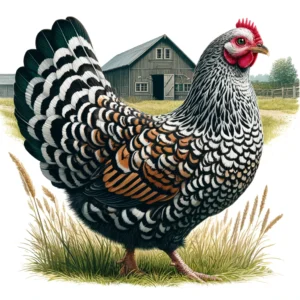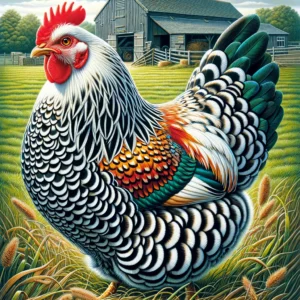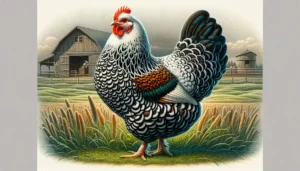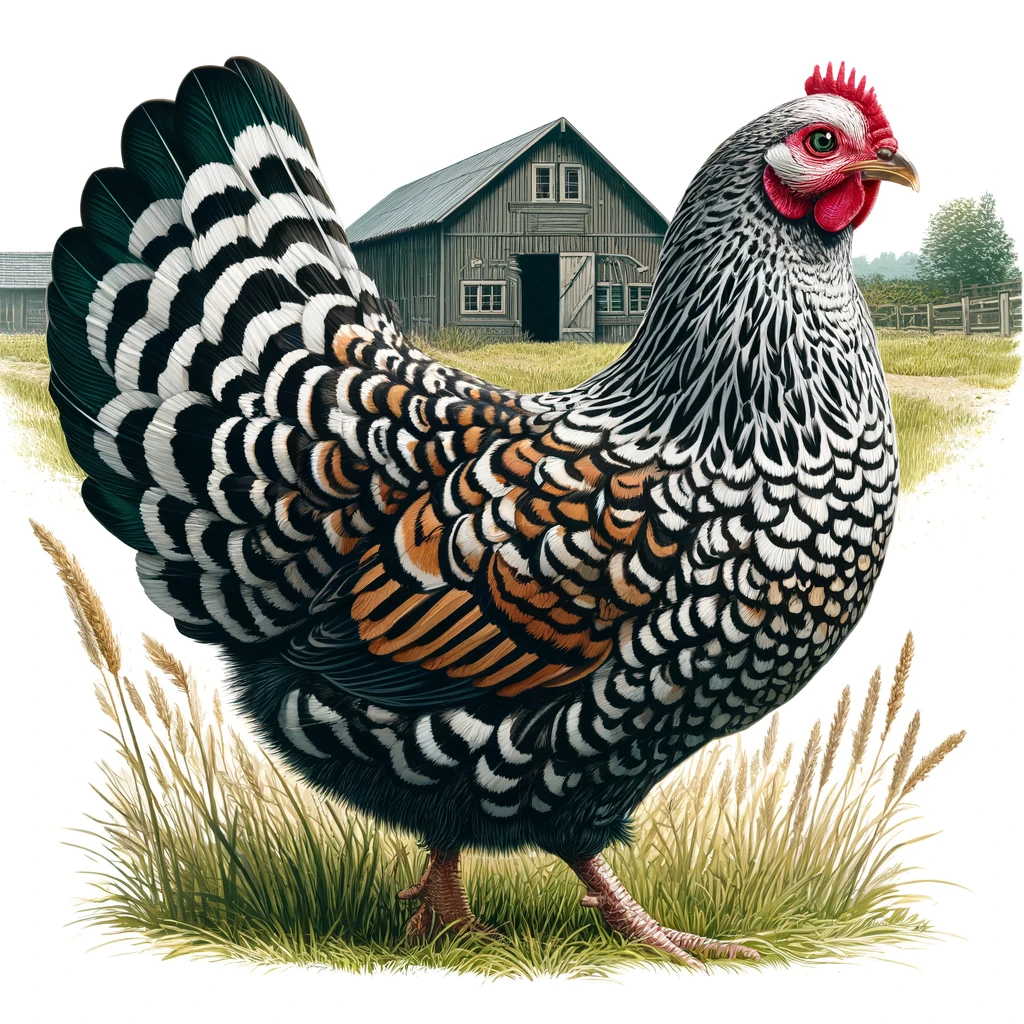The Sussex Chicken: A Comprehensive Guide for Farmers
The Sussex chicken is a beloved breed among farmers and backyard poultry enthusiasts alike. Known for their versatility, hardiness, and pleasant temperament, Sussex chickens are a great addition to any flock. This guide will delve into the breed’s characteristics, history, and practical tips for farmers to ensure their Sussex chickens thrive.
Origin and History
The Sussex chicken is one of the oldest British chicken breeds, with a history dating back over 2,000 years. Named after the county of Sussex in England, these birds were initially developed for meat production. However, their excellent egg-laying capabilities soon made them a dual-purpose breed. Sussex chickens gained popularity during the 19th century and were showcased at the first poultry show held in London in 1845.
Physical Characteristics
Sussex chickens come in several color varieties, including Light, Red, Speckled, and Buff. The Light Sussex, with its white body and black neck and tail feathers, is the most common and recognizable. Here are some key physical traits of the Sussex chicken:
- Size: Sussex chickens are medium to large-sized birds. Hens typically weigh between 6-7 pounds, while roosters can weigh up to 9 pounds.
- Body Shape: They have a broad, rectangular body with a deep, well-rounded breast.
- Feathers: Their feathers are soft and full, providing good insulation against cold weather.
- Comb and Wattles: They have a single comb and medium-sized wattles, both of which are bright red.
- Earlobes: Their earlobes are red, matching their comb and wattles.
Temperament and Behavior
Sussex chickens are known for their calm and friendly demeanor, making them an excellent choice for families and beginner farmers. They are curious birds, often seen foraging for insects and plants. Their sociable nature means they get along well with other chicken breeds and can even become quite affectionate towards their human caretakers.
Egg Production
One of the standout features of Sussex chickens is their egg-laying capability. They are prolific layers, producing around 250-280 large, light brown eggs per year. Sussex hens are also known to lay consistently throughout the winter months, which is a significant advantage for farmers looking to maintain egg production year-round.
Meat Production
In addition to their egg-laying prowess, Sussex chickens are valued for their meat. They have a well-developed breast and succulent, flavorful meat. The dual-purpose nature of Sussex chickens makes them a practical choice for farmers looking to optimize both egg and meat production.
Housing and Environment
To ensure the health and productivity of Sussex chickens, proper housing and environmental conditions are crucial.
Coop Requirements
- Space: Each Sussex chicken should have at least 4 square feet of space inside the coop to prevent overcrowding and stress.
- Ventilation: Good ventilation is essential to maintain air quality and reduce the risk of respiratory issues.
- Nesting Boxes: Provide one nesting box for every 3-4 hens to ensure they have a comfortable place to lay their eggs.
- Perches: Install perches for roosting, with each bird needing about 8-10 inches of perch space.
Outdoor Access
- Run Space: Sussex chickens enjoy foraging and should have access to an outdoor run with at least 8-10 square feet per bird.
- Fencing: Ensure the run is securely fenced to protect against predators.
- Shelter: Provide shaded areas and shelter from rain and harsh weather conditions.
Diet and Nutrition
A balanced diet is essential for the health and productivity of Sussex chickens.
Feed
- Starter Feed: For chicks, use a high-protein starter feed (18-20% protein) until they are 6-8 weeks old.
- Grower Feed: Transition to grower feed (16-18% protein) until they reach 18-20 weeks of age.
- Layer Feed: Once hens start laying, switch to a layer feed with 16-18% protein and added calcium for strong eggshells.
Supplements
- Grit: Provide grit to aid in digestion, especially if chickens are not free-ranging.
- Oyster Shell: Offer oyster shell or another calcium supplement to laying hens.
- Fresh Water: Ensure a constant supply of clean, fresh water.
Health and Disease Management
Maintaining the health of your Sussex chickens involves regular monitoring and preventative measures.
Common Health Issues
- Mites and Lice: Regularly check for external parasites and use appropriate treatments if necessary.
- Respiratory Issues: Ensure good coop ventilation and cleanliness to prevent respiratory diseases.
- Bumblefoot: Inspect feet regularly for signs of infection and provide clean, dry bedding.
Vaccination and Deworming
- Vaccination: Consider vaccinating your flock against common diseases such as Marek’s disease.
- Deworming: Implement a regular deworming schedule to keep internal parasites at bay.
Breeding Sussex Chickens
Breeding Sussex chickens can be a rewarding endeavor for farmers.
Selecting Breeders
- Health: Choose healthy birds free from disease and with good body condition.
- Characteristics: Select birds that exhibit desirable traits such as good egg production, meat quality, and temperament.
- Genetic Diversity: Avoid inbreeding by introducing new bloodlines periodically.
Incubation and Hatching
- Natural Incubation: Sussex hens can be broody and are often good mothers. Allowing hens to sit on their eggs can be a natural way to hatch chicks.
- Artificial Incubation: Use an incubator with consistent temperature (99.5°F) and humidity (45-50% for the first 18 days, increasing to 65-70% for the final days).
Market Potential
Sussex chickens have strong market potential for both eggs and meat. Their reputation for quality and productivity makes them a popular choice among consumers.
Egg Sales
- Farmers Markets: Selling eggs at local farmers markets can provide a steady income stream.
- Direct Sales: Offering eggs directly to consumers through farm stands or subscription services can build a loyal customer base.
Meat Sales
- Local Butchers: Partnering with local butchers or meat shops can help in selling Sussex chicken meat.
- Farm-to-Table: Promoting a farm-to-table approach can attract consumers interested in sustainable and locally sourced food.
Sustainable Farming Practices
Incorporating sustainable farming practices can enhance the health and productivity of your Sussex chickens while benefiting the environment.
Pasture-Raised Chickens
- Rotational Grazing: Implementing a rotational grazing system allows chickens to forage on fresh pasture, improving their diet and reducing feed costs.
- Soil Health: Chickens naturally aerate the soil and help in pest control, promoting a healthier farm ecosystem.
Organic Farming
- Organic Feed: Using organic feed and supplements can produce organic eggs and meat, which often fetch higher market prices.
- Natural Health Remedies: Incorporating natural health remedies and treatments can reduce reliance on antibiotics and chemicals.
Educational Resources
For more in-depth knowledge about farming and raising chickens, consider exploring Farmer Cowboy’s education resources. Additionally, the Agriculture Dictionary and the World Agriculture Directory are excellent references for agricultural terms and contacts.
Conclusion
The Sussex chicken is a versatile and valuable breed for farmers, offering excellent egg and meat production, a friendly temperament, and ease of care. By providing proper housing, nutrition, and health management, farmers can ensure their Sussex chickens thrive. Whether you’re a seasoned poultry farmer or just starting, the Sussex chicken is a breed worth considering for your flock. For more information on agribusiness, dairy farming, and ranching, visit Farmer Cowboy, Dairy, and Ranching. For the latest news in agriculture, check out Farmer Cowboy’s news section, and don’t forget to explore their insights on farming and rodeo.



